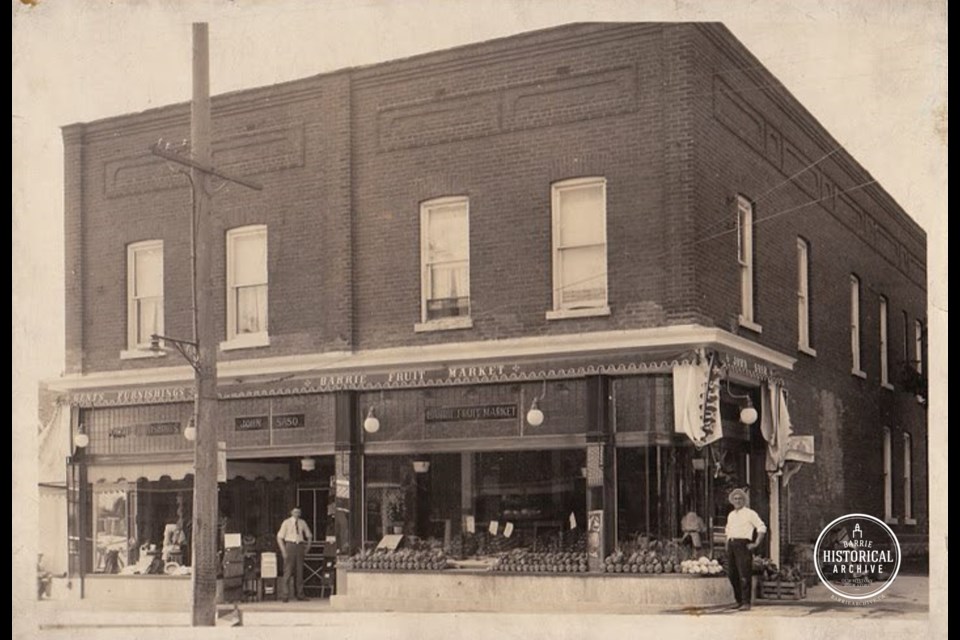This ongoing series from Barrie Historical Archive curator Deb Exel shows old photos from the collection and one from the present day.
The Barrie Fruit Market
The Sasos had been in the fruit business since about 1907. Their busy shop was located at 40 Elizabeth St., which is now the corner of Dunlop Street West and Maple Avenue. John Saso regularly donated food to local shelters and actively contributed to his community.
In May 1928, John Saso, two other main-street merchants and one theatre owner had a moment of notoriety in court for breaching a bylaw which prohibited placing obstructions on the streets of Barrie.
Charles Robinson, of Robinson’s Hardware, was charged with having fence wire on the street. His lawyer informed the judge that Mr. Robinson would plead guilty — although Robinson maintained the wire was only on the street because he had no other place to put it — and abide by the decision of the court.
The magistrate refused to register a conviction without personal consent, so Mr. Robinson was phoned to come to court where he accepted his fine of $3, plus $2 in costs.
Mrs. Beatty, owner of the Dreamland Theatre, being unfamiliar with the bylaw, had her case adjourned. She did, however, agree to move her signs and subsequently paid her fine of $2 plus costs, for a grand total of $3.
John Saso and Herbert Jarvis, the two other offenders, both pleaded not guilty to the charges. Jarvis, who was also first deputy-reeve, was a former fruit and vegetable peddler before buying the Brett Feed Store about 1924 (where Camera Craft was later located) and settling into a downtown storefront. Jarvis’s shop was kitty-corner to Saso’s fruit market and the two fruit merchants conducted their own defense in court.
As the cases were heard, Police Chief Stewart testified that Jarvis had two boxes with a plank on top forming a shelf that protruded 12 to 18 inches from the building onto the sidewalk. The shelf held baskets of beets, onions and other vegetables.
The chief had advised Jarvis that he was breaking a bylaw and told him to take the vegetables in. Jarvis challenged that the previous year he had laid concrete between his building and the sidewalk for the purpose of displaying his goods, at his own expense, and after consulting with the chief.
Discussion regarding the actual width of the plank (possibly only 10 inches, not 12 or 18), the fact that the eaves of the Brett building (one of the oldest in the area) were 12 inches, discrepancies in the documented depth of the sidewalk on the south side of Elizabeth Street versus the actual dimensions, and the 33 clauses to Bylaw No. 270, which was first signed into law on July 3, 1879 by Mayor W.B. Ardagh, all made for heated arguments.
But ultimately, Jarvis was fined $5, including costs. He did not pay right away.
In the Saso case, Chief Stewart charged that bunches of bananas were hanging outside the store, trespassing in city ‘space’ on both Elizabeth Street and Maple Avenue.
Mr. Saso claimed that he took the bananas in whenever he was asked to do so.
The magistrate admonished Mr. Saso for speaking when he was not in the witness box, to which Saso replied: “All right, Judge. I go there."
Once in the witness box, Mr. Saso asked if there was not room for four bunches of bananas – not the 10 or 12 as stated. He went on to say that the four bunches of bananas that he hangs out every Saturday morning are not on city property and if they drop, they fall on his property.
'Bananagate' continued with Mr. Saso admitting that is was possible his bananas were protruding onto the sidewalk by a couple of inches, but only if the police chief would admit there were only four bunches of bananas not 10 or 12.
At the end of the day, Mr. Saso was convicted and paid his fine of $2, with no added cost, due to the very slight technical breach with no intent to commit it.
Although Saso and Jarvis were said to be "bitter rivals and not on speaking terms," they were seen driving away together in Jarvis’s car, smiling and commiserating with each other. A court official was heard to remark: “Misery does love company.”
Just a few years later, John Saso would make undeniably his greatest contribution to the community. Indulging his passion for movies, he sublet the New Dreamland theatre on the west side Bayfield Street, just south of Five Points, in 1930, retrofitting it for sound movies. He then went on to hire an architect to build a lavish theatre just west of his fruit market. The Roxy theatre opened on Aug. 13, 1931.
John Saso kept his fruit store open until midnight to sell to the after-theatre crowd.

